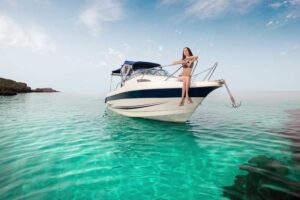There is a boat for every p erson and activity, as well as every budget. There is no doubt that a boat is a large investment of your most precious resources, and getting into the right boat for you and your family is the most critical aspect of satisfying your dream to boat. Look for answers to your most frequently asked questions throughout this section of your guide.
erson and activity, as well as every budget. There is no doubt that a boat is a large investment of your most precious resources, and getting into the right boat for you and your family is the most critical aspect of satisfying your dream to boat. Look for answers to your most frequently asked questions throughout this section of your guide.
Which type of boat is right for me?
Since you are thinking of joining the 18 million Americans who enjoy recreational boating, you probably have an idea about the kinds of fun on the water that your boat will provide. One of the terrific things about boating is that there are boats designed for different activities, and there truly is something for everyone.
To narrow down your search, simply ask yourself what will the boat be used for. Fishing and generally enjoying local waterways? Waterskiing, wakeboarding and exciting watersports? Cruising with family and friends? Racing? A little of everything? There is a boat that’s right for you.
What type of hull is right for me?
Hull is the structural body of the boat that rests in the water. There is no perfect hull. All boats are compromises among performance, useable space and cost. To simplify the process of choosing, here are a few categories to consider when deciding what hull design is right for you.
- Flat bottom boats (such as a jonboat) plane on top of the water, thus allowing the boat to go very fast. But they are difficult to control and do not perform comfortably in choppy conditions.M
- Vee hulls (like an offshore center console fishing boat) with flatter bottoms amidship aft (towards the back) are designed to cut through the water and make the boat start planing. The hull has chines and strakes to lift the boat up when it goes fast enough. The deeper the vee, the easier it will be to cut through choppy waters. As you may expect, the tradeoff is less stability. A shallower vee (such as a deck boat) is more stable in choppy water at lower speeds, but will not “cut through” the waves as easily at higher speeds. A wider beam (the boat’s width at its widest point) will increase these effects.
- Multihull boats utilize two or three deep vee hulls which cut through chop exceptionally well, while maintaining stability due to the width of the boat between hulls. The main drawback to a multihulled boat is its lack of interior space, though boat designers seem to be doing a better and better job at reducing this drawback.
- Round hulls (such as a trawler or sailboat) are displacement hulls (as opposed to planing hulls). These boats are restricted to relatively slow speeds but are very fuel efficient. A displacement hull tends to create a gentle motion while underway, although rolling from side to side in waves can be a problem.
When considering the size of the boat, consider how many people will be boating with you, what type of waters you will be boating in (flat or choppy), what activities you plan on doing while boating, and whether or not you plan to trailer the boat. To help you find the boat that is right just for you, you can use our boat selector tool, which will help you narrow your choice of boat types to the one that is right for you and your family.
What type of Engine should I get for my boat? Choosing the right type of propulsion system for your boat is a very important matter. Its weight and horsepower will both have an impact on the performance of your vessel. If your vessel is underpowered, its engine will work hard continually and will provide poor performance. Here are pros and cons for each type of engine.
When is the best time to buy?
You can find a great deal on a boat at any time throughout the year. Like cars, there are often year-end specials when new models come out. In fact you can often find the best deals on brand new boats that are a year or two old. And you will likely find “show specials” at the hundreds of annual boat shows across the country. Nonetheless, the best time to buy is simply when you are ready. People who are new to boating have a lot to consider. Your families and friends should be part of the decision-making process. It’s a good idea to take a safe boating course while searching for your boat, so you are ready to hit the water as soon as the title is transferred.
Should I buy new or used?
We recommend shopping new first. You will gain insight into which type of boat is best for you and the market price. You can comparison shop for similar pre-owned models. Think about warranties when comparing new and pre-owned. Then you can zero in on your perfect boat!
If I buy used how do I know the boat is in good condition?
Get a qualified marine surveyor’s inspection. Surveyors will check all systems, as well as the hull structure. Call several insurance companies in your area for recommended surveyors. You can also check out www.nams-cms.org or www.marinesurvey.org.
How do I learn how to boat? The waterways around the country are getting quite busy, creating less “room for error” on the water. It is important to learn how to drive your boat; to boat smart, from the start. For starters, every person who is even considering boating should take a boating safety course. Boating safety courses are inexpensive and critical for learning the “Rules of the Road” on waterways. The U.S. Coast Guard Auxiliary and the U.S. Power Squadron have teamed up across the country to make it convenient and easy to learn how to boat. Most waterfront communities offer a number of opportunities to take classes at boat stores, colleges, and community centers. Generally, they meet one evening a week for 7-9 weeks in the fall or winter, although other arrangements are available. The only expense is the workbook, a minimal expense for the knowledge you will gain by taking these classes. For information on classes in your community, click here.
Many people are surprised to find out how affordable boating can be. It is, nonetheless, a good idea to keep in mind that there will be expenses after the boat is purchased. You should budget for sales and personal property taxes, storage, slip rental, fuel, maintenance and insurance. A lot of things will impact the extent of these expenses, including where you boat, where you keep the boat, the age of the boat, how you use the boat, hull material and quality of construction. As a rule of thumb, you will spend approximately $50 per foot annually to operate, maintain, store and repair your boat if you are a do-it-yourselfer. Costs can be as high as $150 per foot if you hire professionals to keep your boat shipshape. It is a good idea to contact marinas and storage facilities where you plan to boat to find the rates they charge. This expense varies tremendously from place to place. In addition to these annual costs, expect to go on a shopping spree when you first purchase the boat to outfit it with new docking, navigational, safety, and electronic equipment, as well as all of the miscellaneous aesthetic additions that make the boat your own. Some boat stores offer outfitting packages for new boaters which can save you money. If you are financing the boat, you can sometimes include some of these larger purchases in the initial boat loan amount.

